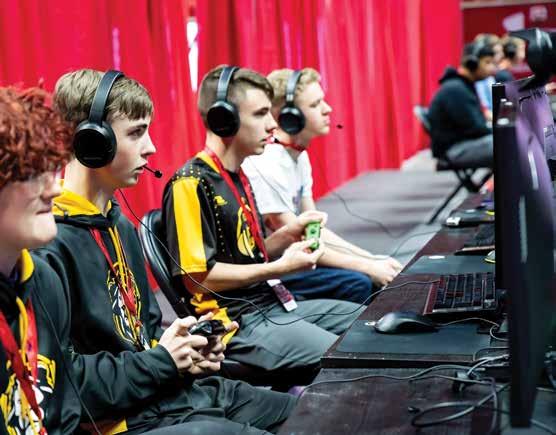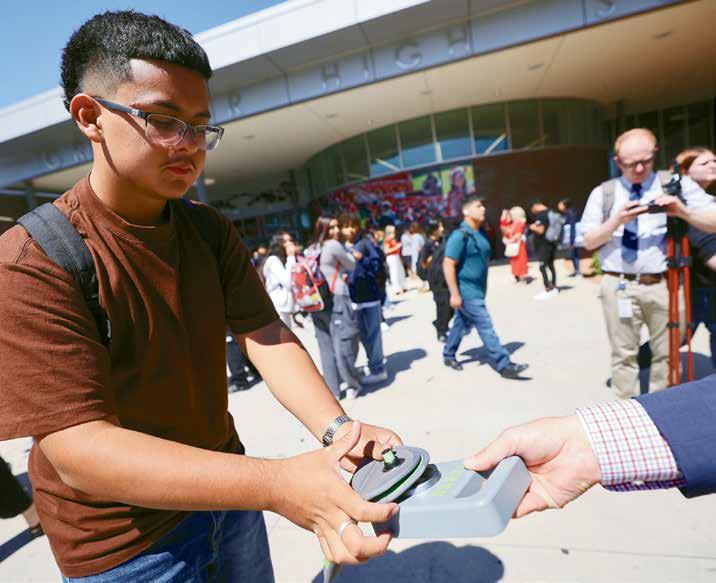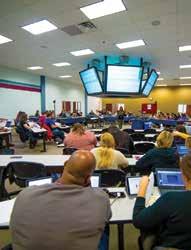
// UTAH LEADERS MAP BRIGHT FUTURE FOR EDUCATION IN 2025
HOW ONE UTAH MIDDLE SCHOOL ACHIEVED A REMARKABLE ATTENDANCE TURNAROUND





// UTAH LEADERS MAP BRIGHT FUTURE FOR EDUCATION IN 2025
HOW ONE UTAH MIDDLE SCHOOL ACHIEVED A REMARKABLE ATTENDANCE TURNAROUND



The Utah Education Policy Center empowers educators, policymakers, and leaders to make research actionable and impactful across early childhood, K-12, and higher education. We offer research, evaluation, professional learning, and technical assistance and capacity building services tailored to the needs of our partners, and designed to support innovation, transformation, and sustainable progress.
At the UEPC, our partnerships and collaborative work are guided by five key principles that advance meaningful impact:
Building and sustaining trust
Promoting inquiry and shared understanding
Ensuring effective communication and coordination
Respecting the expertise and experience of each partner
Advancing continuous improvement through research insights


SHOWUPFORTEACHERS.ORG



Northwest Middle School boosts student engagement through strong community building
UTAH EDUCATORS LAUNCH AMBITIOUS PLAN TO STRENGTHEN READING SCORES
New statewide literacy initiative aims to enhance student reading achievement through targeted support

Simple solutions help families build stronger connections, including outdoor activities and quality time together
Editor: ABBY COX
Guest Editors: KATHARINE B. GARFF CHRISTINE IVORY
Assistant Editor: LYNDA HORNE
Design and Layout: MEGAN DONIO, SERINA NELSON
Cover and opposite page photography: MELISSA MAJCHRZAK
Additional Contributors: JASON SWENSEN, KRISTIN MURPHY, MARIYA MANZHOS MARJORIE CORTEZ, LOIS M. COLLINS, ZOË PETERSEN
Our work Elevating Education would not be possible without generous support from our sponsors.
SHOW UP FOR TEACHERS PRESENTING SPONSOR:
Educators offer insights on bridging generational communication gaps in the classroom
SOCIAL MEDIA CAN HELP OR HURT THOSE WHO STRUGGLE WITH MENTAL ILLNESS
Even subtle messages could make a difference, according to a study in the Journal of Clinical Psychology
SURE
Data reveals that cell phone-free schools will enhance student engagement
UTAH LEADERS MAP BRIGHT FUTURE FOR EDUCATION IN 2025
The Deseret News hosted a roundtable featuring educators, mothers, lawmakers, business leaders, philanthropists and Utah high school students. What did they have to say?
HONORS IN EDUCATION PRESENTING SPONSOR:


It has been a privilege to spend the past four years visiting schools and classrooms across our state. Regardless of their size or location, Utah schools are filled with passionate teachers and dedicated administrators who work tirelessly to ensure every child receives the highest quality education. Their commitment goes beyond meeting basic requirements; I have witnessed firsthand how they actively seek innovative programs and create meaningful opportunities that empower our children to reach their fullest potential, build resilience, and develop into well-rounded individuals.
While teachers consistently go above and beyond to help their students succeed, it takes a united effort from all of us—parents, businesses, community leaders, and policymakers—to create an environment where teachers can truly thrive. Investing in our teachers is an investment in Utah’s future. This means providing them with the necessary resources, recognizing their invaluable contributions, and fostering a culture that honors and respects the teaching profession.
I encourage you to consider how you can support and champion the incredible educators who play such a vital role in shaping our state’s future. Together, let’s continue to uplift the teaching profession and celebrate all Utah educators.





OUR MISSION:
Provide every student in Utah the opportunity to participate in the Special Olympics Unified Sports program.
471% increase in K-12 school Unified Sports teams across Utah since Show Up's involvement
The next Unified Sports Basketball Tournament is on: MARCH 26, 2025



Encourage youth to choose service as a way of life and work with local nonprofits to provide service opportunities to families and individuals.
4,950+ attendees at the annual Show Up for Summer Service fairs
The next Service Fair at Thanksgiving Point Electric Park is on:
JUNE 9, 2025




OUR MISSION:
Promote teacher wellness and elevate the profession to attract, support, and retain the most talented and dedicated educators.


OUR MISSION:
Create a positive connection between the community and foster families to increase recruitment and retention and work with local businesses to provide Foster Family Nights Out for youth in care.
6,000+
educator attendees at the three annual Show Up for Teachers conferences
The next Show Up for Teacher's Conference is on:
JULY 10, 2025
3,500
attendees at Foster Family Night Out events
Northwest Middle School boosts student engagement through strong community building.
By Marjorie Cortez
Four years ago, the percentage of students at Northwest Middle School who were chronically absent was cringeworthy.
Coming out of the pandemic, the school’s attendance rates “were horrendous,” so much so, the Salt Lake City school was held out in a district meeting to make the point “OK, we got to work on this,” said Principal Andrea Seminario.
Northwest was hardly the only Utah school struggling with consistent student attendance but Northwest’s rate of students who were chronically absent was far above the statewide average of 27%.
“We were like 42% the first year,” Seminario said, wincing.
Chronic absenteeism means a student misses 10% or more of enrolled days, according to state school board rule.
Fast forward to the 2023-24 school year and Northwest Middle School once again was being singled out, this time for its strategic efforts that have drastically improved school attendance.
The percentage of chronic absences is now between 10% and 13%, less than half of the statewide average in 2022. As an

Northwest
added bonus, discipline referrals at the school are down, too.
The school, which serves 540 students in grades 7 and 8, has embraced a multi-pronged, intentional strategy to get Northwest students to attend school every day.
The school has embraced the Ron Clark Academy’s house system. All students and adults in the school belong to one of four houses, Isibindi, Nukumori, Rêveur and Sollevare. Each house has its own color, symbols, nation of heritage and history.
For instance, Nukumori is the house of
kindness and its color is purple.
Members of each house have T-shirts of the color that corresponds with their respective houses and the shirts are worn on the school’s spirit days. Students also carry binders that are their house color so their membership is readily identifiable.
The system is intended to create a positive climate and culture for students and staff. Houses compete against one another for rewards. A house with the lowest absences, for instance, is rewarded with a field trip or a party at school.
The teams also compete in “minute to win it” type challenges.
Seminario said students want to win the contests and rewards, of course, but they also do not want to let their housemates down so they feel more compelled to come to school.
Seminario traveled to Atlanta for training on the house system and later sent some faculty members, who are now house leaders.
Each day, the teams’ rates of absences or other school goals are displayed on a screen in the cafeteria so students are constantly aware of their progress toward their goals or their need to step up their efforts.
It’s all part of building culture and community in the school.
“Kids want to belong. If you walk into our school, the first thing you see is, ‘You belong.’ Our theme is, ‘I am Northwest.’ We want kids to be proud to be from the west side, from the Rose Park area. What does that mean? It means that you got to show up all the time,” she said.

Northwest teachers are expected to take roll within the first 10 minutes of the school day to give the school’s attendance secretary a jump on reaching out to parents whose children are absent.
Sometimes parents are unaware their child is not at school because the parents are working and they expect their child to get ready and get to school on their own. Other times, the parents are home and once they get a call from the school, most bring their child to school.
The school has also created a variety of clubs to encourage school attendance, develop students’ interests and to have fun.
Teachers and administrators asked the students what clubs they wanted, “and
that’s how we got our anime club and our dance club, all these things they wanted,” she said.
“They want to be here. They’re safe, there’s food, there’s connections, there’s tons of clubs,” Seminario said.
Seminario said parents are important partners in getting their children to school consistently.
Northwest holds monthly parent meetings to encourage them to get their children to school — and on time — and to get better acquainted with educators and administrators.
“We have a food pantry that’s available to our families after our monthly
meetings. That also helps to build those relationships where they know we’re taking care of our families and our families trust us. Again, it’s just getting them to come,” she said.
Parents often do not realize that even two absences a month is considered chronic, she said. “Even if they’re excused absences, they’re still absent,” Seminario said.
If students start racking up absences, the attendance secretary checks in with their parents and offers assistance.
If things don’t improve, the secretary schedules appointments for the student and their parents with a school counselor. They set goals and establish a meaningful reward for the student if they meet the goals. If the absences persist, the student is referred to school administrators.
School personnel also make home visits to educate parents why regular school attendance is important and to offer help with barriers such as transportation or offer to intervene if another student is bullying their child.
“It’s a parent’s responsibility, and the parents call, right? So we just need our parents to really back us up with this initiative and understand it’s trying to help the whole child, but they have to be here. They have to show up. Every day counts,” she said.
Seminario said the school’s cell phone policy, which prohibits their use by students from 8 a.m. to 2:30 p.m. has also curbed bullying, she said.
Reducing the school’s rate of chronic absences has been hard work but the rewards are substantial because teachers, administrators and staff spend their time helping students reach their academic and social goals instead of laboring just to get them in the door.
“It’s just so much energy and work to decrease that and then to sustain that because you get new kids every year that you also have to train, and those parents you have to retrain,” she said.
The percentage of Utah students who were chronically absent shot up from 13% in 2018 to 27% in 2022.
The upward trajectory post-pandemic is worrisome because regular school attendance is linked to higher levels of student achievement and lower dropout rates compared to peers who are chronically absent.
Salt Lake City Mayor Erin Mendenhall and Salt Lake City School District Superintendent Elizabeth Grant recently teamed up to stress the importance of regular school attendance in Utah’s capital city.
They released an Instagram video
“ Kids want to belong. If you walk into our school, the first thing you see is, ‘You belong.’ Our theme is, ‘I am Northwest.”
message that urges families to reach out to their child’s school principal who can help them obtain resources to help them address barriers to school attendance. For instance, schools can help families obtain food, clothing and free UTA bus passes provided by Salt Lake City and the Salt Lake City Education Foundation.
Mendenhall said chronic absences can negatively impact students’ long-term goals.
“Every day that students miss has an impact on their potential to graduate. I know as a working mom with three kids, that is a big impact on our family when one of our kids has to miss school. There’s a lot of reasons that can happen, but to think about the cumulative impact and the potential on their long-term success, attendance is one of those key indicators,” she said.
Grant said missing school affects students’ futures.
“We are all about building opportunities for our students. We need them here to take advantage of college and career pathways. Students need to be in school,” she said.
According to the Utah State Board of Education, a student who is chronically absent in any year, starting with their eighth grade year, is seven times more likely to drop out than a student who is not chronically absent.
“Did you know that about a quarter of our students are missing 18 days a year? That’s a lot, and it’s similar to other schools nationally. But you know what? We can fix it here in Salt Lake City. We need to get our kids to school every day, because every day counts,” Grant said. //
WGU School of Education is the largest nonprofit, accredited college for educators in the country, with over 100,000 educator alumni working across all 50 states.* Our initial licensure programs are AAQEPand CAEP-accredited.
• Affordable tuition. Most universities charge tuition by credit hour—if you take more courses, you pay more money—but not WGU. We offer flat-rate tuition. That means whether you complete eight courses in a term or 20, your tuition won’t change.**
• National network. We partner with more than 5,000 school districts nationwide to provide clinical experiences and student teaching at scale—wherever students live.
• Unparalleled flexibility. Courses are designed for working professionals. Coursework and tests are available anytime, anywhere, so you can earn a degree on your schedule.






“BYU-Pathway helped me rebuild my academic confidence after a 10-year break. I was able to continue working and study around a schedule that worked for my family. I’m currently waiting for my graduate school acceptance letters!”
Shannon Jex, Washington, USA
X Save time and money by eliminating elective credits
X Guaranteed tuition discounts

Fewer Credits. 100 % online. Learn More byupathway.edu
X Spiritual and supportive environment
X Fully accredited degrees
In partnership with BYU-Idaho and Ensign College, BYU-Pathway Worldwide provides access to online certificates and degrees.







Higher
Applied
Constitutional
Secondary

New statewide literacy initiative aims to enhance student reading achievement through targeted support
By Jason Swensen

Assessing Utah students’ overall performance on a recent national test is akin to countless parent-teacher conference reports: doing well overall — but some areas need improvement.
Results from The National Assessment of Educational Progress 2024 scores — aka “The Nation’s Report Card” — were released in January, revealing mostly steady performance for Utah fourth- and eighthgrade students who participated in the test.
In fact, only three states or jurisdictions outperformed Beehive State students.
But the decline in Utah’s eighth grade reading scores — reflecting national trends in declining reading performances — caught the attention of the state’s education leaders.
“More children are falling below the proficient level, underscoring the critical need to double down on effective reading interventions and support for our students,” said State Superintendent of Public Instruction Sydnee Dickson in a Utah State Board of Education release.
In other areas such as math, Utah students are holding steady.
“Fourth grade reading levels remained unchanged, and no other significant shifts were observed in the state’s scores,” the board of education report noted.
Utah males outperformed their Utah female counterparts in math in both fourth and eighth grade.
Conversely, Utah females scored higher than Utah boys in reading in both fourth and eighth grade.
Approximately 2,000 fourth and eighth grade Utah students participated last year in the national assessment group’s math and reading portions of the test. The same tests were administered in 2024 to students in all states, the District of Columbia and Department of Defense schools.
The Nation’s Report Card assessment results are reported as average scores on a 0-500 scale.
The group’s 2024 reading assessment included literacy and informational texts to assess students’ reading comprehension skills.
Meanwhile, the math assessments measured students’ knowledge and skills in mathematics — and their ability to solve problems in mathematical and realworld contexts.
• In 2024, the average math score of fourth grade students in Utah was 242 — higher than the average score of 237 for students in the nation.
• The average score for Utah fourth grade students in 2024 (242) was not significantly different from their average score in 2022 (240).
• The average math score for Utah fourth grade males was 245. For females, 238.
• In 2024, the average math score of eighth grade students in Utah was 282 — higher than the average score of 272 for students in the nation.
• The average math score for Utah eighth graders (282) was not significantly different from their average score in 2022 (282).
• The average math score for Utah eighth grade males was 283. For females, 280.
• In 2024, the average reading score of fourth grade students in Utah was 219 — higher than the average score of 214 for students in the nation.
• The average reading score for fourth grade students in Utah in 2024 (219) was not significantly different from their average score in 2022 (221).

• The average reading score for fourth grade female students in Utah was 223. For males, 216.
• In 2024, the average reading score of eighth grade students in Utah was 261 — higher than the average score of 257 for students in the nation.
• The average reading score for eighth grade students in Utah (261) was lower than their average in 2022 (265).
• The average reading score for eighth grade females students in Utah was 265. For males, 258.
Responding to the NAEP results, the state board of education has committed to identifying the causes of declining reading scores — while implementing “targeted efforts and proven strategies.
“Our focus is on ensuring measurable improvements in reading outcomes by working with schools to equip educators and students with tools and targeted training,” said Darin Nielsen, deputy superintendent of student learning in the state board report.
“We are committed to implementing evidence-based programs that address

reading challenges early, providing intensive support where it’s needed most, and tracking progress to make sure every student has the opportunity to improve and succeed.”
Across the United States, reading scores are plunging.
The national results from the 2024 national assessment indicate a twopoint drop, on average, for both fourth and eight graders across the country — sustaining a steady decline in the subject that predates COVID-19-era disruptions, according to an Education Week report.
In math, eighth grade scores were unchanged from 2022, the last time the test was given. Fourth graders’ scores rose two points, but remained below their performance in a similar test administered in 2019.
“The news is not good,” Peggy Carr, the commissioner of the National Center for Education Statistics, which administers NAEP, said in the Education Week report.
“We are not seeing the progress we need to regain the ground our students lost during the pandemic, and when we are seeing signs of recovery, they’re mostly in math, and largely driven by high-performing students,” Carr added. “Low performing students are struggling, especially in reading.”
Utah legislative audit: Performance gaps among student groups
Carr’s words echo local concerns shared last month by state auditors in a report presented to Utah’s Legislative Audit Subcommittee.
The audit revealed a “statewide gap between the performance of students who are in a group that traditionally struggles with academic proficiency, and those who aren’t.”
The report classified “underperforming student groups” as those who have a higher than typical chance of performing below proficiency “and who are economically disadvantaged, learning English, or racial or ethnic minorities.”
Such “underperforming student groups” frequently need the most growth and support, the report added.
Auditors reviewed five years of data showing how many Utah students moved from “below proficient” to “proficient,” and vice versa.
“Looking at the net percentage proficiency change each for five years, the percent of students who changed their proficiency status remained problematically low,” their report noted. “Both state and local education agency level observations create a case for school districts and charter schools to reevaluate the effectiveness of their student intervention programs.”
Local education agencies such as school districts and charter schools, the report recommended, should make an effort to identify students in need “and intervene quickly at the first signs of difficulty.” //




In August, U.S. Surgeon General Dr. Vivek Murthy issued a landmark advisory on parental mental well-being. The report highlighted unprecedented levels of stress among parents and caregivers, driven by worklife imbalances, societal pressures and economic uncertainties. This advisory sparked a national conversation about the need for systemic change and stronger community support for families.
The intensity of modern parenting may be impacting the decision of young people to have children. According to a February 2024 Pew Research Center poll, 30% of 18to 34-year-olds without kids aren’t sure they want to have children — an increase compared to earlier surveys among those who said they “were not likely at all” to have children. Emily Oster’s new podcast tackled perhaps the most significant question on the mind of many, including the economists studying declining fertility rates: should you have children at all?
Simple solutions help families build stronger connections, including outdoor activities and quality time together
By Mariya Manzhos
Meanwhile, buzzworthy book releases by authors like Jonathan Haidt and Abigail Shrier renewed conversations about fostering emotional resilience in children, and offered parents insights into how they can help their kids thrive in an increasingly complex world.
So what challenges defined parenting in 2024, and how can parents navigate these challenges better in the coming year? Here’s what people at the forefront of the conversation said.
One of the biggest challenges for parents in 2024 was managing children’s screen time while fostering interpersonal skills. As technology increasingly dominates everyday life — whether in education, entertainment or social interactions — parents have struggled to strike a balance. School absenteeism has surged
to unprecedented levels, with a growing number of children and teens citing severe anxiety as the primary reason for not going to school.
The rise of AI-driven content and highly captivating platforms online has subjected children and teens to advanced algorithms specifically engineered to grab and sustain their attention, according Rachel Marmor, mental health counselor and chief wellness officer at the PAIRS Foundation, a nonprofit dedicated to relationship education. She also noted parents wrestling with the blurry lines between productive and harmful tech use.
“While digital tools are vital for learning and development, distinguishing between constructive and detrimental screen time became harder for parents,” she said in response to questions from Deseret.
Jonathan Haidt’s book “The Anxious Generation: How the Great Rewiring
of Childhood Is Causing an Epidemic of Mental Illness” has underscored the correlation between the rise of smartphones and social media and the increase in mental health issues among adolescents. Haidt argues that the shift from a play-based to a phonebased childhood has led to higher rates of anxiety, depression and self-harm among teens, particularly those born after 1995. Haidt identifies factors such as social deprivation, sleep disruption, fragmented attention and addiction as key contributors to this mental health crisis.
“Once young people began carrying the entire internet in their pockets, available to them day and night, it altered their daily experiences and developmental pathways across the board,” Haidt wrote for The Atlantic. “Friendship, dating, sexuality, exercise, sleep, academics, politics, family dynamics, identity — all were affected. Life changed rapidly for younger children, too, as they began to get access to their parents’ smartphones and, later, got their own iPads, laptops, and even smartphones during elementary school.”
Since its publication, Haidt’s book has sparked debates among parents, educators and policymakers about the necessity of regulating children’s access to smartphones and social media. Florida, Ohio, South Carolina and Louisiana among other states have adopted laws to restrict and ban phone use in schools. Many other districts across the country are limiting smart phone use inside schools, or considering bans.
The U.S. Department of Education called on every state, district and school to adopt policies that guide the use of student personal devices in schools, and released “Planning Together: A
Playbook for Student Personal Device Policies,” a guide to help create effective policies for the use of personal devices like smartphones in schools.
In support of Utah’s Devices in Public Schools bill, Elliana Crabtree, a junior at Tooele High School, wrote in a column published in the Deseret News in December: “I’ve taken measures to avoid certain platforms, yet somehow I still end up averaging three to four hours on my phone per day, which could be much better spent on more worthwhile pursuits. Yet, as I mentioned earlier, resisting the pull of technology is designed to be an uphill battle.”
When it comes to parenting approaches, helicopter parenting — characterized by restrictions aimed at shielding children from failure or discomfort — has been slowly giving way to more balanced, empowering approaches. An incident in Georgia, in which a mother was arrested for letting her 10–year-old son walk by himself into the town’s center, brought into focus another tension parents are facing: how to help children develop independence and resilience while keeping them safe.
“There’s no parent alive who knows where their kid is every single second of every single day,” said Lenore Skenazy, the author of “Free-Range Kids” and co-founder of the nonprofit Let Grow. “It’s not bad to not know where your kid is all the time, and to make it into a new normal that you must be tracking your kid is disturbing.” The organization has been helping to change neglect laws across the United States; by the end of 2024, Let Grow helped change laws
in eight states, including Utah, Texas, Colorado and Virginia.
Skenazy hopes Georgia can be the next state to make a change. “We argue that the law should be that neglect equals when you put your kid in obvious and serious danger, not any time you take your eyes off of them,” Skenazy said in an interview, adding that parents don’t want to have their decisions be secondguessed by the government. “They want the government to stop abuse of children, but they don’t want to be micromanaged,” she said.
To foster healthier childhood development, Let Grow offers free programs for schools to make it easier and more “normal” for kids to engage in independent activities. For instance, the organization has a free curriculum for younger and older children that includes a homework assignment where kids go home and do something on their own without their parents’ supervision. “And because it’s the school that is telling parents to let their kids try this, parents do,” Skenazy said.
It’s a win win outcome, she said. “It not only feels great for the kid, it feels great for the parent because they’re so proud of their kid.” This exercise can spur a chain reaction normalizing independent behavior across neighborhoods. Another school program, Let Grow Play Club, conceptualized by Peter Gray, allows kids of all ages to play before or after school — often at a school playground — without adults intervening. Children are developing a “remarkably high order of thinking” during play, according to Gray, writing
for the magazine Plough Quarterly; play helps them develop resilience, creativity and social skills.
Embedding children in stable, real-world communities is also essential as these connections are more fulfilling than online networks, according to Haidt. When introducing phones, parents should start with devices designed solely for communication, delaying smartphones until high school, along with limiting access to social media until then, he says.
But parents, eager to solve their child’s problems, should not rush to a therapist’s office because the experience may actually hurt them instead of helping them. This is what Abigail Shrier argues in her 2024 book “Bad Therapy: Why the Kids Aren’t Growing Up.”
In the book, Shrier, an investigative journalist, examines how over-reliance on therapy has contributed to mental health problems among children and teens. She criticizes the “one-size-fitsall” approach to therapy in schools and asserts that excessive therapy, especially in schools, can sometimes worsen symptoms, promoting rumination and reinforcing negative emotions. She advocates for a more cautious approach, where children are given opportunities for independence, set boundaries, and are taught to manage their emotions without overemphasis on therapy.
Shrier told the Deseret News in an interview in April, “We need parental authority. We need high expectations. We need boundaries and rules for our kids. We need community for them. We need extended family around them. And they need independence, genuine opportunity for independence, without our help.”
Reflecting on the Georgia incident, Camilo Ortiz, a clinical psychologist, told Deseret News in November that fostering resilience in children requires them to face difficult situations, which sometimes involve a certain degree of risk. He recommends exposing children to what he calls the “4 Ds” — discomfort, distress, disappointment and danger — to help build their sense of self-worth and resilience. For example, allowing a 10-yearold to walk a mile in a generally safe area involves a manageable level of risk and provides emotional benefits. Ortiz applies this approach in his “independence therapy,” which encourages children to engage in independent activities, like walking alone or cooking a meal, to reduce anxiety and promote personal growth.
“Now is the moment when people are recognizing this is something that kids need and we can all do it together,” said Skenazy. “The way we’re putting it is: take away the phone and open the door.”
‘Focus on peace in the home’
What happens inside the home will ultimately shape the kids’ behavior outside of it.
Kenneth Ginsburg, a pediatrician specializing in adolescent medicine at the Children’s Hospital of Philadelphia, recommends “focus on peace in the home and strengthen our families,” he said in an email.
During the past year, with the contentious presidential election, the divisive rhetoric and disagreements have seeped into households, according to Ginsburg. He has advocated for what he calls “lighthouse parenting,” a balanced approach that combines warmth, love and structure to foster resilience and confidence in children. At its core, he said, parenting is about building enduring family relationships, focusing on humanity and resilience over perfection. He suggests choosing a respectful tone in family interactions that reinforces that despite disagreements, “we all must build a better, more humane world together.”
“Be forgiving and compassionate within our homes. Be present for our children and create safe spaces where they know they are deeply loved and protected,” said Ginsburg. “Part of the safety of our home is that people can differ in our opinions, but our love for each other is never questioned.” //
“ The way we’re putting it is: take away the phone and open the door. -Lenore Skenazy
At my529, Utah’s official educational savings plan, we help you invest for education so you can help your children and grandchildren follow their dreams.
Contributing even a small amount now to a 529 college savings account can help make college or vocational school more affordable later.

529 savings can be used at any eligible educational institution—university, college or technical school in the U.S. or abroad that qualify to participate in federal student financial aid programs. my529 can help make the process of saving for higher education easy! Save for college. Inspire their future.®
Investingisanimportantdecision.Theinvestmentsinyouraccountmayvarywithmarket conditionsandcouldlosevalue.CarefullyreadtheProgramDescriptioninitsentiretyformore informationandconsiderallinvestmentobjectives,risks,chargesandexpensesbeforeinvesting.For acopyoftheProgramDescription,call800.418.2551orvisitmy529.org.

active learning. active life.” approach to education will prepare you for the classroom and life through real-world se ings. Experienced and student-centered faculty will guide you as you begin your teaching journey.
Utah Tech o ers the most a ordable university tuition in the state, 300 days of sunshine, and was recently ranked one of the best universities in the west.
Special Education (Coming Soon) PROGRAMS
Elementary Education
Secondary Education
Educators offer insights on bridging generational communication gaps in the classroom
By Jason Swensen

School teachers in Utah and across the country are formally trained educators in history, math, biology, chemistry and a host of other academic subjects.
They’re also America’s front-line squad of amateur linguistic anthropologists.
So if you’re a bit confused hearing the kids at the family holiday party saying “skibidi” or “delulu,” and feel you need a translator — just find a school teacher.
They are likely fluent in Slang2024.
But slang fluency doesn’t mean teachers are always fans of whatever words or phrases are trending.
Yes, Henry David Thoreau may be attributed with saying “It is too late to be studying Hebrew; it is more important to understand even the slang of today.”
But did Thoreau’s readers ever call him “bruh”?
Education Week recently asked educators across the country to share slang terms they wished their students would trash. They gleaned hundreds of teacher responses and compiled a “Slang that Teachers are Sick of Hearing” top-10 list.
A caveat before sharing the list: Not all teachers are slang-averse. School psychologist Jill Davidson noted in a LinkedIn comment that slang can “enrich our language, (and) encourage creativity. It’s important to know what they mean and how they’re used.”
Now, on to Education Week’s “Top-10 list — Slang that Teachers are Sick of Hearing.”
The slang term for “the best” can be used to describe, somewhat curiously, someone who is an “alpha.”
That’s a slang word to describe a slang word.
A contracted form of the word “charisma.”
Can be used as a noun or verb — and it’s high praise for someone’s charm, style and vibe.
Rizz is what kids in 2020 would have called “game.”
Refers to a “really cool outfit” or clothing items or accessories with statementmaking style and, well, maximum rizz.
Ate
Looks and sounds just like the verb you have used forever after finishing a meal — but now with no food context.
Instead, “ate” is used to “praise someone for doing something well” or having good style.
Example: “Wow, that’s amazing! You really ate that performance.”
Bruh
The evolved version of “bro.”
Used mostly as a friendly greeting or when referring, typically, to a male friend.
A flexible slang, “bruh” can also be used to express surprise (Bruh!!!) or disagreement (Bruh …).
Skibidi
A nonsense word defined by context. It can mean “cool” or “dumb” or “bad”— or just about anything else.
It’s filler fodder. And it’s little surprise “skibidi” would make the teacher’s top-10 slang trash list.
It sounds like “delusional” for a reason. It’s a shortened version of the word, by four letters.
Delulu is also a humorous way to describe someone rejecting reality in favor of a more appealing interpretation.
Example: “Mike’s delulu about the Packers’ chances of winning the Super Bowl.”
Low-key
A familiar but stylized version of “low key” that describes someone’s actions or emotions that don’t draw too much attention.
“Low-key”, according to USA Today, can be used, ironically, as high praise. Saying someone is “low-key” means “they are calm, don’t cause drama and usually keep to themselves.”
Bet
You probably still say, “You bet.” Your
parents or grandparents surely said, “You bet.”
Your kids: just “bet.”
Like its earlier iteration, “bet” is typically used as a substitute for “OK.”
Me: “Want to grab some lunch?”
You: “Bet.”
A fairly recent slang that gained traction following people’s social media reactions to the 2024 presidential election results.
Loosely, “crash out” means to “become hysterical or do something reckless, or to pass out from exhaustion.”
Of course, once a slang term is widely adopted it’s already being replaced by fresh slang. That’s the rule.
So what slang can teachers expect to hear — and probably hate — in 2025?
Education First has already identified the slang “you need to know in 2025”:
Yap: Gossiping excessively.
Chat: A group of people.
Brain rot: Feeling mentally drained from social media overload.
Yassified: Glamorized and overdone.
Lore: Something’s backstory or context.
And, finally, “That’s tea” = That’s the truth. //
Even subtle messages could make a difference, according to a study in the Journal of Clinical Psychology
By Lois M. Collins

Older teens and young adults spend a lot of time on social media. And the messages they encounter there could be key to helping or hurting those who struggle with anxiety and depression. Even subtle messages could make a difference, according to a study in the Journal of Clinical Psychology.
Researchers from Ohio State University found that college students approached managing their depression and anxiety differently depending on whether the messages they saw had a
“growth mindset” or a “fixed mindset.” A growth mindset creates optimism because it suggests mental health can get better with effort or treatment or by taking proactive steps. The condition is not set in stone.
A fixed mindset suggests that being set in stone is the reality. What is simply is, and would be difficult to change. So if you have anxiety and depression, that’s just the way things are.
Because young adults spend so much time on social media — the
322 undergraduate students who participated in the study said they used social media one to three hours a day — the messages they encounter regarding mental health there can be life-giving or sapping.
“These relatively subtle messages may be influencing whether they believe they have any possibility of working through their depression and anxiety and getting better,” Whitney Whitted, study lead author and a doctoral student at Ohio State University, said in a written statement.
Finding ways to tackle mental health is tremendously important, experts agree. The National Institute of Mental Health believes as many as 19.1% of all adults have anxiety.
Among college students, numbers are startling. In an annual survey of 96,000 U.S. students on 133 college campuses during the 2021-22 academic year, 44% had symptoms of depression, 37% said they had anxiety and 15% said they have seriously contemplated suicide. That was the highest share in the 15-year history of the Healthy Minds survey.
As Jean Twenge, author of the books “Generations” and “iGen,” wrote on her Substack, young adults are now
more likely to die by suicide than are middle-aged adults, which is a significant change in a longstanding trend. Mental health is a major challenge for young people.
In the study, participants saw a series of messages about mental health on the social media site X. Each was randomly assigned to view tweets about mental health through the lens of a growth mindset, a fixed mindset or the control, in which tweets said nothing about mental health.
For the growth mindset, the tweets focused on how fluid mental health can be and one’s ability to take control of mental health. For example, one message was “I got this” on a meme that said “telling those anxious thoughts who’s really in control.”
An example of a fixed mindset message was a tweet that read, “I can’t wait for my seasonal depression to be over so that I can get back to my regular depression.”
After they read the tweets, the undergrads were surveyed about how long depression and anxiety normally last and if they will ever go away, as well as about the effectiveness of treatment for depression and anxiety and whether study subjects thought they could take control
of their own mental health and recover or relieve their symptoms.
Participants who read the growth mindset messages were more likely to believe that the two conditions are not necessarily permanent and there are things they could do to help themselves. Those with the fixed mindset tweet “had less optimistic views about the permanence of mental illness and the ability of people to treat it,” the news release said.
Even such a short intervention mattered, according to Jennifer Cheavens, a professor of psychology at the university and a study coauthor. “It was just a few minutes of people reading these tweets with small variation in how the messages about mental illness were framed,” she said. “But it made a difference in what these participants reported they believed.”
“Social media communication that characterizes psychopathology from a growth mindset perspective may be a viable intervention for improving beliefs around mental health selfefficacy and the malleable nature of mental illness, particularly depression and anxiety. Clinicians may be able to use social media platforms to promote functional beliefs around mental illness,” the researchers concluded.
The researchers noted they could not say how long the changes would last. But they are hopeful that growth-mindset social media messages will encourage people with depression or anxiety to seek help. And it could be a boon to those who are in therapy, to bolster their confidence that they will get better.
“We want our clients to put in the hard work necessary to overcome their problems, but they have to believe it is possible,” Cheavens said. “This study suggests there may be ways to give them a boost, to help persuade them that working hard in therapy can pay off in the end.”
“It is important that the messages they receive accurately reflect what we know about mental illness, especially the fact that it is treatable,” Whitted said.
Study co-authors include Matthew Southward, of the University of Kentucky; Kristen Howard, of the Milwaukee VA Medical Center/ Medical College of Wisconsin; Samantha Wick, of Miami University; and Daniel Strunk, of Ohio State. //










The mission of Success in Education is to provide pathways to college or careers. We do this through literacy, technology, mentoring programs, and exposure to scholarships, internships, and careers.


Success in Education is a 501c3 nonprofit, serving every school district in the state of Utah with four core education-based programs:















Huntsman Graduate. Rodeo Queen.
Sales and Trading Analyst. Competition Winner. Woman in Business. Risk Taker.






Data reveals that cell phone-free schools will enhance student engagement
By Jason Swensen

Utah first lady Abby Cox recently talked all things cellphones with her adult son, Gavin — a young man raised during the first generation defined by the ubiquitous devices.
Now married, Gavin told his mother it’s up to his generation to “get kids off phones.”
The potential harm of cellphones — particularly in the school classroom — was not really known or discussed much when Gavin was a kid.
“But now we know the damage,” said Abby Cox, “and we can’t turn around. We can’t pretend.”
A mother of four with a degree in special education, Utah’s first lady uses her unique platform to champion education. She’s alarmed by classroom challenges such as teacher mental health, caring for special needs students and recruiting “the best and brightest” to the profession.
But few things trouble Cox as much as the divisive issue of cellphones in public school.
“I’m concerned about making sure that teachers have the tools to provide instruction without the constant interruptions of phones in school,” she said during an educational roundtable hosted by the Deseret News.
Cox was joined in the recent discussion by a collection of educators, business leaders, a lawmaker, parents and a student.
All agreed cellphones and classrooms are a bad mix.
And Utah’s lawmakers apparently agree. Proposed legislation would
prohibit cellphones in Utah’s K-12 classrooms — although local districts and schools would be allowed to opt for a different policy.
The first lady’s husband, Utah Gov. Spencer Cox, leaves little doubt about his disdain for cellphones in schools:
“We talked about learning loss during COVID-19 and it was severe. But if you go back and look at the data, learning loss in our country and all over the world started in about 2012, when these smartphones became ubiquitous.”
The data indicating that the hazards of cellphones in classrooms “is just getting so overwhelming” that it’s hard to refute, said Cox during the education roundtable.
She’s quick to point out the proven positives of keeping kids off their devices at school — celebrating the “unbelievable differences” at Granger High School after it implemented a “no cellphone” policy.
Granger High students, she said, are interacting more — and learning more.
Abby Cox has heard the arguments that kids need access to their cellphones in case of a school crisis, such as an active shooter.
But the data, she counters, reveals cellphones in school can make a bad situation worse.
“They are jamming up signals. They’re at higher risk if there was a shooter than if (students) were not using their phones.”
Roundtable panelist Rich Nye, a senior adviser to the governor, said student cellphone use during an emergency or threat within the school grounds “compromises even a response to the situation” because students don’t have “the full story.”
Luz Matos, a Granger High student body officer, added that if there was an active shooting situation at school, “getting on your phone would be the last thing you would want to do.”
Abby Cox also challenges arguments that kids should have full access to their cellphones during school because the devices are private property.
“There are myriad things that we don’t allow our kids to have in school that are private property. … We don’t let them bring guns or knives.”
“ There are so many things that we don’t allow our kids to bring into the classroom because they are distracting — so why is a cell phone any different? - Abby Cox
Even harmless toys that distract from classroom instruction are typically off-limits.
“There are so many things that we don’t allow our kids to bring into the classroom because they are distracting — so why would a cell phone be anything different?” said Cox.
Matos said her high school successfully manages cellphone use by requiring all students with phones to use a “Yondr pouch” — a small, secure bag that uses a magnetic locking mechanism to store a phone.
When Granger students enter the school, they place their phone in the pouch that is then automatically locked. When they exit the school, the magnetic lock is automatically released.
Philanthropist and public education advocate Kathi Garff told the roundtable she would “100%” support a “no-phones-in-school law” because “I see the effect that it has in the classroom.”
Roundtable participant Cherie Sadowski, a mother from the Canyons School District, voiced her support of cellphone prohibitions at school. Prior to her child’s elementary school implementing a “no cellphone” policy, many of the youngsters would spend recess tapping away on their devices.
“There’s no reason why they should be on their phones,” said Sadowski. “They should be out running around. That’s why there’s recess.”
Utah third grade teacher Gina Vaughn said she is witnessing students with diminished social and creative thinking skills, “because they are stuck on those screens so much at home — and even when they go out with their friends.”
Several years ago, South Sevier Middle School Principal Michelle Nielson began requiring students to place their cellphones in “caddies” whenever they enter a classroom or other learning environment.
There was some initial pushback from students and parents. But Nielson posed this question to any upset by the phone caddy rule: “Is your child being able to check social media during class more important than what they are learning in class — and it can’t wait until class break?”
More than half of Utah’s public and charter schools are following some sort of classroom cellphone policy, according to Nye.
“The others are waiting to see what the state does before they have to go through the process of rewriting policies to match,” he said. ”However,
“
the (proposed state law) just sets the expectations: Let’s keep phones out of schools.”
Abby Cox added that “bell to bell” cellphone restrictions in school are preferable to simply prohibiting devices during classroom instruction. She recalled a Utah school principal reporting, happily, that the lunchroom was “much noisier, once they had ‘bell to bell’ because the kids were actually talking to each other.”
According to Harvard University researcher Dylan Lukes, existing studies provide evidence that allowing phones in the classroom negatively impacts test scores and long-term learning retention.
“In psychology, research on multitasking generally finds negative effects on learning and task completion and, more generally, research has shown that cellphones distract and negatively impact reaction times, performance, enjoyment of focal tasks and cognitive capacity,” Lukes said. //
We talked about learning loss during COVID-19 and it was severe. But if you go back and look at the data, learning loss in our country and all over the world started in about 2012, when these smartphones became ubiquitous.”
- Utah Gov. Spencer
Cox
Now Leasing for 2025-2026

The Ivory University House represents a new model for student housing and supporting higher education. The Ivory Family, The Church of Jesus Christ of Latter-day Saints and the University of Utah have come together to provide 621 academically-focused students with an opportunity to live next to campus.
All rent proceeds will be donated by the Ivory Family to a new scholarship fund at the University of Utah, supporting students from all walks of life, including first-generation students, by providing scholarships and housing assistance for thousands of students over the next 99 years.
Amenities include on-site gym, wellness resources, recital/lecture hall, on-site tutoring, wellness programming, music practice, community rooms, study areas, outdoor gathering spaces, game rooms and an art studio.


SCAN THE QR TO LEARN MORE:





MASTER’S PROGRAMS
M.S., M.Ed., M.Ed. with Secondary Licensure or ESL Endorsement
» Education, Culture & Society
» Educational Leadership & Policy
» Educational Psychology
» Special Education
DOCTORAL PROGRAMS
Ed.D., Ph.D., Joint M.P.A.-Ph.D./Ed.D.
» Education, Culture & Society
» Educational Psychology
» Educational Leadership & Policy (fully remote available)
» Special Education
FOR CURRENT TEACHERS
Certificates
» Community College Leadership & Teaching
» Positive Psychology (fully remote available)
» Statistics Endorsements
» Special Education
• Severe Disabilities
• Mild/Moderate Disabilities
• Preschool & Early Intervention
• Board Certified Behavior Analyst
• Visual Impairments
• Deaf & Hard of Hearing
• Deafblind
» ESL Endorsement (12-months)
We are a capital city College of Education at the only AAU institution in the state. Let us train you to become the K-20 administrators, non-profit professionals, STEM educators, and mental health innovators who will transform Utah’s educational landscape.

The Deseret News hosted a roundtable featuring educators, mothers, lawmakers, business leaders, philanthropists and Utah high school students. What did they have to say?
By Jason Swensen

The Deseret News hosted a recent roundtable featuring Utah first lady Abby Cox and a rich collection of educators, mothers, a lawmaker, business leaders, philanthropists and a Utah high school student to discuss education in the Beehive State — and its many challenges and opportunities. The conversation was moderated by Doug Wilks, executive editor of the Deseret News. (Some responses have been edited for clarity.)
When it comes to educating our children, what concerns you?
Abby Cox, first lady of Utah:
“At the top of that list is certainly teachers.
“It’s been the focus of my initiative for the past four years to create an environment in the state where teachers can thrive —
because I think that’s upstream of taking care of the problems that are happening.
“In order to keep our teachers — and to get the best and brightest in education — we have to address the issues that are leading to teacher burnout and teacher retention.
“Mental health and wellness is also at the top of that list.
“I’m concerned about making sure that our teachers are supported in all the ways that they need.”
Katharine B. Garff, board chair with Garff Enterprises and The Success and Education Foundation:
“Making sure we reach all children. And ‘all’ means all. I don’t think we have a right to exclude any children, and I’m particularly concerned about rural areas.
“I think we have an obligation to not be territorial. And I think we have an obligation to reach all children — whether they have disabilities, whether they are of different races — it doesn’t matter.
“It does not matter what the issues are.
… We have an obligation to save Utah by reaching all of our children. We have an obligation as community members to pitch
in, roll up our sleeves and fill in the blanks — because we can’t do it any other way.”
Amanda Covington, Larry H. Miller Company, chief corporate affairs offices/ chair, Utah Board of Higher Education:
“From a higher ed perspective, I’m worried about losing students between K-12 and higher education — whether that means attending a technical college … or pursuing bachelor’s degrees.
“Education changes lives. It’s a differentiator for families. It empowers critical problem solving and makes better, stronger communities. When when see about 40% of high school graduates in our state not entering some sort of post-secondary education, that’s a worry for me.
“What’s happening to those 40%?”

Ann Millner, Utah state senator, former president of Weber State University:
“My biggest worry is third grade reading.
“Having every child reading at a third grade level by the end of third grade is fundamental to them being successful in everything else we do. We can do all the things we want to do after that — but we’re going to leave kids behind if every child is not reading at a third grade level by the end of third grade.
“Less than half our kids were reading at third grade at the end of third grade — which means they’re less likely to graduate from high school. It means that they are more likely to end up in our social service system or our criminal justice system.
“We need to focus on helping every child learn to read.”
Sydnee Dickson, Utah state superintendent of public instruction:
“We are losing sight of the importance of public education.
“If we really want to have a wonderful, civil society that’s engaged and contributing to the betterment of everybody — if we want to have creators and doers and makers — we have to provide a quality public education for our students. I worry that we’re losing sight of that.
“We have chronic absenteeism, meaning that students are missing 10 or more days of school. If you look at the root cause of absenteeism, we have economic reasons. Kids might stay home to babysit other kids. We lack quality child care.
“I worry that kids are disengaging with the school, and parents and society are not seeing the value of school. We have
to do our part in making school more relevant and engaging; where kids have a lot of choices.”
Sarah Allred, first lady’s director of initiatives:
“I want to make sure that education is not excluding anyone — and that our students come out as good humans. We need to be intentional in connecting and engaging with school and engaging with each other.
“We want good humans — people that can problem solve and think outside the box. Self-starters.”
Christine Ivory, co-founder and director, Clark and Christine Ivory Foundation:
“I am very concerned about the parent side of things.
“Parents are the first and most important teachers. When parents get, say, out of the reading loop, then the kids aren’t reading.
“It’s not a public school’s responsibility to make a child healthy and whole and kind and good. That lies with parents.
“I hope that we can find ways to engage parents, but this can get divided in lots of complicated ways. You’ve got technology and phones and all it’s all playing a very heavy role in early childhood.”
Gina Vaughan, third grade teacher, Franklin Elementary:
“I have seen a lot of teachers that are leaving the teaching profession within the first 10 years of their careers.
“Over the last 10 years, teachers have seen so many different changes like the pandemic and other things — and they’re just burned out.
“Another worry is kids are falling behind and not learning to read at that third grade level. And then I just worry the gap is getting bigger. You’re seeing kids drop out and not seeing them not even going to junior high.”
Michelle Nielson, principal, South Sevier Middle School:
“The mental health of our students and their ability to handle all the things in life weighs heavy on my mind.
“How do we help them know that we are here to help with those things beyond just providing instruction?”
Cherie Sadowski, parent, Canyons School District:
“Teacher retention. We’ve got excellent teachers leaving the profession.
“Another concern is class size. Just because there are 35 students in our elementary classroom, doesn’t mean there should be.”
Abby Cox, first lady of Utah:
“Some teachers are completely overwhelmed with the amount of behavior issues.
“You have just an enormous range of negative behaviors in the classroom that teachers are dealing with, day-to-day.”
What are the solutions for resolving concerns about K-12 education in Utah — and reasons for hope?
Rich Nye, governor’s education adviser:
“Outside of the home and the family, no one wants a child to succeed more than

educators. And when we see that break down, we have to get to work and we have to create systems for them to be successful — whether it’s their third grade reading or whether it’s moving students into higher ed.
“All of it would be entirely overwhelming if it weren’t for the fact that there is so much good in Utah education. Every single day, in every single classroom, something amazing is happening in the life of a child. That can be overstated.
“It’s always a challenge — but it wouldn’t be a challenge if we didn’t care so much.”
Katharine B. Garff, board chair, Garff Enterprises and The Success and Education Foundation:
“I’m a real believer in public schools. We need to pay more for teaching at
our schools. Our schools need to be safe. They need to be technologically up to date.
“And teachers need parent support.”
Sydnee Dickson, Utah state superintendent of public instruction:
“We want kids to be problem solvers, creative thinkers and communicators. How do we design our system towards that?
“We admire the problem a lot … but we don’t always take action. And so we need (parent/community support) groups that take action by focusing on what to do for kids in their community.
“We live in a world where kids have got to learn how to be creators. In order for kids to be creators and contributors, there’s certainly a set of skills that they need.

“Sen. Millner is running a very exciting bill called ‘First Credential.’ We want to create conditions and opportunities for every student to leave our high schools with a first credential from industry or an associate’s degree. We have a lot of data that shows that they’ll go on and be more successful in post-secondary offers.
“There’s got to be a shift in the way we think about school. We need a more personalized experience for kids. And we need to set up those conditions to meet those personalized needs.”
Christine Ivory, co-founder and director, Clark and Christine Ivory Foundation:
“We need to be willing to identify (issues) and do something about it — even if it’s unpopular.
“We’ve got to elevate parents again and help them understand that their role in education is critical.”
Luz Matos, student body officer, Granger High School:
“I definitely see myself going to college.
“I talk with other students and they say, ‘I’ll just go work at Walmart after high school.’
“But education is becoming more accessible every school year, in my opinion. There are more opportunities to earn scholarships and find resources.
“Education is important — and I think everyone should go for it, because it does make you a better person.” //
Roseman University is training the next generation of compassionate and highly competent healthcare providers in pharmacy, nursing, dental medicine and graduate studies to thrive in the ever-changing world of healthcare.
With more than two decades of building from a firm foundation to a broad universe of healthcare education, Roseman continues to develop innovative programs that train a diverse student body to be exceptional leaders in their chosen fields. We look ahead to the limitless promise of the future, in providing our communities unparalleled patient care, scientific discovery, and commitment to improving healthcare outcomes in our region and beyond.
Developed Roseman’s Six-Point Mastery Learning Model®, changing the way healthcare students learn
Developed the first and only College of Pharmacy in Nevada, with an innovative, accelerated three-year program
Developed hybrid-online and on-campus Accelerated BSN programs
Developed an innovative, three-year, team-based DMD program
Developed the first Master of Pharmaceutical Sciences program in the Intermountain West
Transforming Education. Reimagining Healthcare. Embracing Discovery. Committed to Community. Learn more at roseman.edu
roseman.edu | @rosemanuhs











Get the Financial Support You Need with an Educator Mini-Grant
Educator Mini-Grants from Cyprus Credit Union help teachers fund innovative classroom projects and purchase additional supplies.
Apply for an Educator Mini-Grant and discover our teacher resources.
With Cyprus Credit Union's free, engaging financial literacy resources, educators can enhance curriculum and equip students with real-world financial knowledge.
